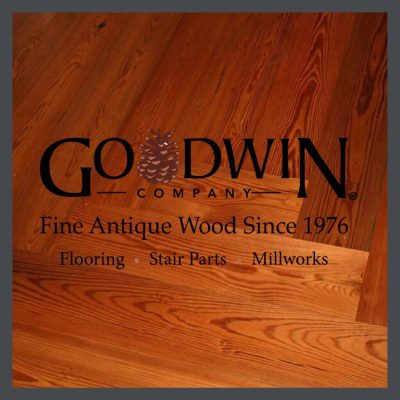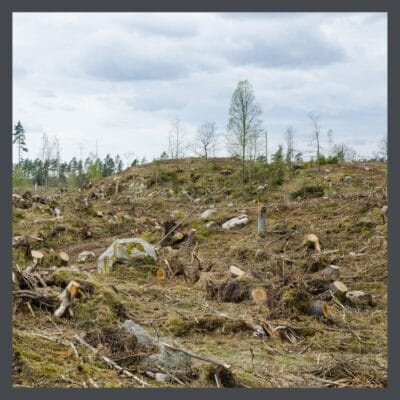by Dennis Prieur (usually known as Hubby) & Carol Goodwin, of the Goodwin Heart Pine Company
 Heart pine floors in bungalows is one of the most appreciated features of our charming homes here in the South, where they are deservedly revered. They gleam a warm welcome as you come in the door, bringing an element of the natural world into the built environment. But what is “heart pine?”
Heart pine floors in bungalows is one of the most appreciated features of our charming homes here in the South, where they are deservedly revered. They gleam a warm welcome as you come in the door, bringing an element of the natural world into the built environment. But what is “heart pine?”
Carol Goodwin of Goodwin Company has been working with heart pine since 1976. They pride themselves with being an eco-friendly company, rescuing logs or using only wood that has been sustainably harvested throughout the Southeast.
Goodwin Heart Pine is famous for its recovery & milling of pine logs from the bottoms of the rivers on which they were floated to the mills over 100 years ago. If you should need extensive patching of your floor, or wish to add an area, they can provide the material for you that will match the existing.wood in your house. This is a terrific video about how they recover the logs.
Carol is a lover and student of history and a supporter of historic preservation. One of my favorite projects of theirs was an adaptive re-use of a barn built in the 1930’s for which they provided over 2,000 square feet of reclaimed wood.
HEART PINE FLOORS IN BUNGALOWS
 The “heart” of the pine tree is the solid, inside core of the tree. It contains no sap, the watery fluid that circulates through the tree, carrying nutrients to the leaves and various tissues. Heartwood is wood that has died with age. As the tree grows, more heartwood is formed. The heartwood becomes more resistant to decay and termites as a result of genetically programmed chemical changes in the wood, causing the clogging of the nutrient tubes with resin and pitch. If you were to cut a cross section of a tree, you would see heartwood as a darker colored circle, usually following the annual rings in shape.
The “heart” of the pine tree is the solid, inside core of the tree. It contains no sap, the watery fluid that circulates through the tree, carrying nutrients to the leaves and various tissues. Heartwood is wood that has died with age. As the tree grows, more heartwood is formed. The heartwood becomes more resistant to decay and termites as a result of genetically programmed chemical changes in the wood, causing the clogging of the nutrient tubes with resin and pitch. If you were to cut a cross section of a tree, you would see heartwood as a darker colored circle, usually following the annual rings in shape.
True heart pine floors in your bungalow are only from the long leaf pine, also known as long needle, long straw, southern yellow, hard, pitch, heart pine and Georgia pine, among other names. The natural range of longleaf pine extends from southeastern Virginia to east Texas in a belt approximately 150 miles wide adjacent to the coasts of the Atlantic Ocean and the Gulf of Mexico. It dips as far south as central Florida and widens northward into west central Georgia and east central Alabama. This type of pine is called “heart” because when it reaches maturity the tree is mostly heartwood, taking 200 years for a tree to become 2/3 heartwood.
Long leaf heart pine contains almost twice the resin content of other types of pine and has much higher structural strength. It was used for the tall masts of sailing ships and was referred to as “The Kings Pine” when this country was owned by England.
HEART PINE- OUR COUNTRY’S BACKBONE
 Heart pine is generally considered to be timber from first generation trees, trees that were standing when the first settlers landed in this country in the 1600s. Many of these trees had been standing for over 300 years! There were approximately 80,000,000 acres of these trees. This wood was the primary building material for our bungalows and factories here in the South and was shipped to the Northeast and Europe as well. It was abundant, hard, straight, and long and its timbers offered excellent resistance to decay.
Heart pine is generally considered to be timber from first generation trees, trees that were standing when the first settlers landed in this country in the 1600s. Many of these trees had been standing for over 300 years! There were approximately 80,000,000 acres of these trees. This wood was the primary building material for our bungalows and factories here in the South and was shipped to the Northeast and Europe as well. It was abundant, hard, straight, and long and its timbers offered excellent resistance to decay.
The economy of the Southeast centered on the export of longleaf pine products. After the Revolutionary War, intense cutting of the virgin longleaf pine timber began on the Atlantic seaboard and moved inland, then southward, increasing with the development of the railroad system in the late 1800’s.
By 1930 virtually all of the virgin longleaf pine forest succumbed to overcutting. Less than 1,000 acres of virgin timber remains today, with the longleaf pine ecosystem covering less than 3.3 million acres, a greater than 96% loss. The pine forests of the South have been cut several times over and this newly harvested wood exhibits very few of the qualities that made heart pine the wood of choice up until the early 20th century.
Read more about old growth forests here.
GROWING OLD GRACEFULLY
The heart pine floors of our bungalows are a mix of pine heart and sap woods. The heart is a deeper red in color, with the sapwood being lighter. Some of the boards are a mix of these two woods producing a stripy effect.
Sadly, some of our bungalow heart pine floors have been chewed by termites, and are at the ends of their lives. However, many have generations of usefulness left in them with some patching (think spare wood in closets, or a quick call to Carol!) and a gentle refinishing. We happen to think that they look beautiful when showing the patina of age, like any other precious antique. When possible, we prefer just to re-coat them with a new layer of finish which protects the wood from wear. A well maintained floor can be enjoyed for at least another 100 years!
 STAY IN THE BUNGALOW KNOW!!!
STAY IN THE BUNGALOW KNOW!!!
Sign up for our newsletter & receive our FREE E-book, 7 VITAL Things to Do Before You Hire a Contractor.



I have those old heart pine floors from the piney woods in East Texas! Ours is loblolly I think. We are saving what we can.
They sound beautiful! I just love the sound of “piney woods!”